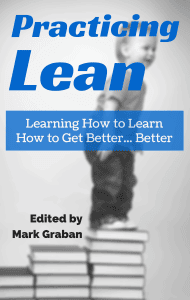 In the spirit of “Lean publishing,” the book Practicing Lean has another new incrementally-added chapter.
In the spirit of “Lean publishing,” the book Practicing Lean has another new incrementally-added chapter.
The latest excellent contribution comes from Jamie Parker, writing about lessons learned in large commercial printing operations… lessons that can be applied anywhere.
I won't give away her childhood story and how she artfully ties that into her early Lean efforts… I'll save that for buyers/readers of the book (which sounds mean of me, but 100% of author proceeds are being donated to the non-profit Louise H. Batz Patient Safety Foundation). That said, the minimum price in the “name your own price” model is $2.49. You can pay the recommended $6.99 or other prices (even voluntarily paying more, if you like).
Here is an excerpt from the middle of the chapter:
A Five Letter Word
Trust. It's a pretty important five letter word. In the lessons I've already shared, you can probably imagine how the mistakes we were making early in our practice of Lean hurt the level of trust our team members had of the organization and of us as leaders. When we first started practicing Lean, we presented it as a way to increase efficiency and cut costs. Combine that with the connotations of the word “lean” itself and we had a problem. Then, add in our misapplication of tools and top-down push of Lean initiatives and the problem only got worse. We created a sense of fear and resentment with many of our team members.
To course correct, we actively worked on changing that by investing in our team members and giving them more opportunities to create change. At one point, we trained our team members on the basics of continuous improvement and focused that effort on what we called daily improvements. Paul Akers of FastCap, author of Chapter Five, calls these “2 Second Improvements.” Essentially, these are improvements that team members can make in their work environment and processes. We created “Improvement Walls of Fame” in each plant where team members could document and share their improvements. It was a great way for them to get recognition and to learn from each other.
However, we had to approach these daily improvements differently than we had started in our practice. We couldn't focus on efficiency or cost cutting as the primary goals; we had already learned that many of our team members viewed that as a way for “the big man upstairs” to make more profit without sharing any of it with them, and some of them were even afraid they would improve themselves out of their jobs. Shigeo Shingo is quoted as saying, “There are four purposes of improvement: easier, better, faster, and cheaper. These four appear in the order of priority.” This became our rallying cry.
We repeated over and over and over to our team members that we wanted their help in making their jobs easier and better. That's it. Those are the first two priorities of improvement and the only thing we asked for. It wasn't just a “flavor of the month” either. Two years later, this remains our rallying cry.
This paradigm shift had a tremendous positive impact on rebuilding trust with our team members. It wasn't about efficiency or costs. It was about making their jobs easier and making their plants a better place to work. Of course, their improvements did make things faster and cheaper, too. In fact, team members regularly made improvements that lowered our costs. I think that's mostly because we didn't ask for it and instead trusted them to make the improvements they found value in. And they trusted us in return. I only wish we had started this way and not put ourselves in a hole to climb out of to begin with.
These are the types of stories being shared in the book. The point isn't for anybody to beat themselves up too much… but to share, with humility, our early missteps and lessons learned.
I appreciate Jamie's participation and look forward to other contributors being a part of this project (click here to express interest in writing something).
You can also hear the Gemba Academy podcast episode where Jamie was interviewed.
Thanks for your support of this project!
[adrotate banner=”140″]
Please scroll down (or click) to post a comment. Connect with me on LinkedIn.
Let’s work together to build a culture of continuous improvement and psychological safety. If you're a leader looking to create lasting change—not just projects—I help organizations:
- Engage people at all levels in sustainable improvement
- Shift from fear of mistakes to learning from them
- Apply Lean thinking in practical, people-centered ways
Interested in coaching or a keynote talk? Let’s start a conversation.





![When Was the Last Time a Leader Around You Admitted They Were Wrong? [Poll]](https://www.leanblog.org/wp-content/uploads/2025/07/Lean-Blog-Post-Cover-Image-2025-07-01T212509.843-238x178.jpg)




![When Was the Last Time a Leader Around You Admitted They Were Wrong? [Poll]](https://www.leanblog.org/wp-content/uploads/2025/07/Lean-Blog-Post-Cover-Image-2025-07-01T212509.843-100x75.jpg)
This is a lovely post.
I have experienced the same with a client, Initial improvement efforts were pushed down and trust was broken.
In an effort to reduce lead times people felt like hamsters in a wheel, they had made things faster, but not better.
To try and rebuild trust we went to the floor and, instead of asking how to make it faster, we asked, what makes it NOT fast? Each Manager and team leader was trained to ask 5 simple questions:
1. What goal are we trying to achieve here?
2. What things are stopping you?
3. Which one shall we fix first?
4. What is your Idea and How can we test it?
5. When can we see the results and discuss what was learned?
With this new approach, they overtook their original “LEAN” results in a matter of weeks.
Their rally cry became “MAKE IT BETTER, SPEED WILL COME!”